
TNU Journal of Science and Technology
229(07): 22 - 30
http://jst.tnu.edu.vn 22 Email: jst@tnu.edu.vn
AN ALGORITHM APPROXIMATES THE HIGHER ORDER DERIVATIVE
WITH HIGH ACCURACY
Vu Vinh Quang, Nguyen Dinh Dung*
TNU - University of Information and Communication Technology
ARTICLE INFO
ABSTRACT
Received:
02/01/2024
When studying and solving practical problems in continuous
environments, through modeling methods, the vast majority of
problems lead to models described by partial differential equations, i.e.
models that contain differential operators. For a very small class of
problems corresponding to simple models and boundary conditions, we
can obtain a direct solution of the problem through analytical methods,
while the vast majority of complex problems can be obtained through
analytical methods. Methods of discretizing differential operators to
convert to systems of difference equations. Then the approximate
solution will be obtained through solving the system of difference
equations based on the tools of an electronic computer. With the need
to obtain solutions with high accuracy, the issue of researching methods
to discretize differential operators with high precision is a research area
of special interest to mathematicians. In this paper, we propose an
algorithm to discretize the n-th order derivative with high-order
accuracy. Theoretical results and experimental calculations have
confirmed the accuracy of the algorithm.
Revised:
28/3/2024
Published:
29/3/2024
KEYWORDS
Derivative
Grid space
Mesh function
Set of neighboring points
Order of accuracy
THUẬT TOÁN TÍNH GẦN ĐÚNG ĐẠO HÀM CÁC CẤP VỚI ĐỘ CHÍNH XÁC
BẬC CAO
Vũ Vinh Quang, Nguyễn Đình Dũng*
Trường Đại học Công nghệ thông tin và Truyền thông - ĐH Thái Nguyên
THÔNG TIN BÀI BÁO
TÓM TẮT
Ngày nhận bài:
02/01/2024
Khi nghiên cứu giải quyết các bài toán thực tế trong các môi trường liên
tục, thông qua phương pháp mô hình hóa thì đại đa số các bài toán đều
đưa đến mô hình được mô tả bởi các phương trình vi phân đạo hàm
riêng tức là các mô hình có chứa toán tử vi phân. Một lớp rất nhỏ các
bài toán ứng với mô hình và điều kiện biên đơn giản, ta có thể thu được
lời giải trực tiếp của bài toán thông qua các phương pháp giải tích, còn
đại đa số các bài toán phức tạp đều thông qua các phương pháp rời rạc
hóa các toán tử vi phân để chuyển về các hệ phương trình sai phân. Khi
đó nghiệm xấp xỉ sẽ thu được thông qua việc giải các hệ phương trình
sai phân dựa trên công cụ của máy tính điện tử. Với yêu cầu cần thu
được lời giải với độ chính xác cao thì vấn đề nghiên cứu các phương
pháp rời rạc hóa các toán tử vi phân với độ chính xác cao là một hướng
nghiên cứu được các nhà toán học đặc biệt quan tâm. Trong bài báo
này, chúng tôi đề xuất một thuật toán rời rạc hóa đạo hàm các cấp với
độ chính xác bậc cao. Các kết quả lý thuyết và tính toán thực nghiệm đã
khẳng định độ chính xác của thuật toán.
Ngày hoàn thiện:
28/3/2024
Ngày đăng:
29/3/2024
TỪ KHÓA
Đạo hàm
Không gian lưới
Hàm lưới
Tập điểm lân cận
Cấp chính xác
DOI: https://doi.org/10.34238/tnu-jst.9516
* Corresponding author. Email: nddung@ictu.edu.vn

TNU Journal of Science and Technology
229(07): 22 - 30
http://jst.tnu.edu.vn 23 Email: jst@tnu.edu.vn
1. Introduction
The vast majority of problems in continuous environments, through discretization of
differential operators, result in models of systems of difference equations based on a suitable grid
space. Then the use of formulas to discretize differential operations with what order of accuracy
will determine the order of accuracy of the discrete solution obtained through algebraic methods
or iterative methods of solving the system of differential equations. Therefore, studying methods
to approximate the derivative value at a point of a function is an important research direction that
mathematicians are especially interested in. In the literature on numerical methods [1], formulas
for approximating the first and second derivatives of the function ( ) with accuracy order
( ) have been given, which uses the value of the function at 3 neighboring points of point
and is denoted as the grid step on the grid space. Based on the interpolation polynomial
approximation method, in the document [2], the m-order derivative approximation formulas with
accuracy order ( ) are given, which uses value of the function at 5 neighboring points of
point . Recently, in the document [3], a set of formulas for approximating derivatives of all
order with accuracy order ( ) has been introduced, which uses the value of the function at
n+1 neighboring points of point . Based on the published formulas, numerical solutions for
differential problems with nonlinear differential equations of all order have been improved. In [4]
– [8], algorithms for numerically solving 3rd and 4th order nonlinear differential equations with
accuracy order ( ) were published.
However, the published results of the above derivative approximation formulas are all results
obtained by the direct method, results obtained by direct calculation of analytical expressions, not
general. Thus, to improve the accuracy of derivative approximation, it is necessary to build a
general algorithm to provide formulas for approximating derivatives of any degree with arbitrary
order of accuracy based on the support of the computer.
The main content of the article will present theoretical research results based on interpolated
polynomials to provide a derivative approximation method, thereby proposing a general algorithm
for approximating mesh derivative vectors with orders of magnitude. Arbitrarily accurate based on
the mesh function at neighboring points, proceed to build general derivative approximation
formulas based on the coefficient matrix determined from the algorithm.
The structure of the article consists of four parts: In Section 1, we introduce some published
results on the method of approximating higher order derivatives. Section 2, we present the
theoretical basis of interpolated polynomials, based on which we propose an algorithm to
approximate higher order derivatives in the case of regular and irregular grids. Section 3, we
present some experimental calculation results to evaluate the accuracy of the proposed algorithm.
Finally, there are conclusions and references.
2. Proposed method
Consider the function ( ) , -. Use a grid to divide segment , - into points
by dividing points Let ( ) is the grid space,
( ( ) ( ) ( )) is the grid function defined on the grid space, ( ) ( ) is the
approximate value of the derivative ( )( ) at point ( ) ( )
( ( ) ( ) ( ) ( ) ( ) ( )) is the -order derivative vector approximated on the
grid space.
Let ( ) is the set of neighboring points of point ( ).
We need to build an algorithm to determine the grid derivative vectors ( ) when we know the
grid function with high-order accuracy using ( ) neighboring points Z.

TNU Journal of Science and Technology
229(07): 22 - 30
http://jst.tnu.edu.vn 24 Email: jst@tnu.edu.vn
2.1. Lagrangian interpolation polynomial [1]
Consider points x in the neighboring grid ( ) . Then suppose
interpolation points are given
...
( )
( )
( )
...
( )
( )
Consider the function approximation method using Lagrang interpolation polynomials in the
neighborhood.
The symbol for Lagrange multipliers is -th degree polynomials that satisfy the property
( ) {
Lagrange multipliers are determined by the formula
( ) ( )( ) ( )( ) ( )
( )( ) ( )( ) ( )
Then we have the formula for approximating the function ( ) in neighborhood Z using an -
th degree Lagrangian interpolation polynomial
( ) ∑ ( ) ( )
( ), (1)
where ( ) is the error of the interpolation method.
Theorem 1 [1]. Let ( ) , -,. Then the error of the interpolation method is
determined according to the formula ( ) ( )( ))
( ) ( ), where is a
point dependent on ( ) ( )( ) ( )( ).
From the formula for approximating the function using the Lagrange interpolation polynomial
( ) we obtain the formula for calculating the order derivative of the function ( ) in the
neighborhood Z. ( )( ) ∑
( )( ) ( )
( )( ) , (2)
So we get the formula to approximate the m-order derivative
( )( ) ∑
( )( ) ( )
(3)
Theorem 2 [2]. The error of the first derivative approximation is determined by the formula
( ) ( )
( ) ∏( )
∑ ( )( )( )
∏( )
. (4)
Since formula (3), inorder to approximate the -order derivative of the function ( ) at
every grid point, we need to develop a method to calculate the - order derivatives of factors.
2.2. Method for calculating factor derivatives
Consider factor ( ) ( ) ( )( ) ( )
( ) ( )( ) ( ).
Let ( ) ( )( ) ( )( ) ( )
( )( ) ( )( ) ( ),
*( ) ( ) ( ) ( ) ( )+.
It is easy to see that ( ) is the product of elements in the set , in which all elements
are present. We set ( ) to correspond to a binary sequence consisting of bits that all
receive the value 1. We have ( )( ) ( )( )( ) ( ) ( )(
)( ) ( ) ( )( )( ) ( ) ( )( )(
) ( ).
( )( ) is the sum of the terms, each term is the product of ( ) elements taken from the
set in the set in which the identical terms are repeated once. We let ( )( ) correspond to a

TNU Journal of Science and Technology
229(07): 22 - 30
http://jst.tnu.edu.vn 25 Email: jst@tnu.edu.vn
binary matrix , each line is a binary vector consisting of bits, of which 1 bit takes the value
of 0. Number of rows in matrix equals
. For example
( )( ) ( ) ( )
( )( ) ( ) ( )
( )( ) ( )( ) ( ) ( )( ) ( ) ( )(
)( ) ( ) ( )( )( ) ( ).
Obviously ( )( ) is the sum of the terms, each term is the product of ( ) elements
taken in the set , in which the overlapping terms repeat 2! time. We let ( )( ) correspond to
a binary matrix , each line is a binary vector consisting of bits which 2 bits receive the value
0. Number of lines in matrix is equal to
. For example
( )( ) ( ) ( )
( )( ) ( ) ( )
In the general case
( )( ) ( )( ) ( ) ( )( ) ( )
( )( )( ) ( ) ( )( )( ) ( ).
( )( ) be the sum of the terms, where each term is the product of ( ) elements taken in
the set in the set where the duplicate terms repeat time. We let ( )( ) correspond to a
binary matrix , each line is a binary vector consisting of bits which bits take the value of
0. Number of rows in the matrix equals
.
After determining the values ( )( ) then
( )( ) ( )( )
, We obtain approximately
the -order derivative of the mesh function determined by the formula
( ) ( ) ∑
( )( )
(5)
where ( ( ) ( ) ( )) is the value of the mesh function on neighborhood Z.
2.3. Proposed algorithm in case of irregular grid
According to the method analyzed, the matrix is common to all ( )( ) If
the matrix can be determined, then determining the derivatives
( )( ) can be done using
the algorithm.
function
( ) Factorial_Derivative( )
begin
( )( ) ;
for =0:
if (i<>k) then ( )
end
for =1: ( )
=1;
for =1:
if ( ) then
end
( )( ) ( )( ) ;
end
( ) ( )( )
end

TNU Journal of Science and Technology
229(07): 22 - 30
http://jst.tnu.edu.vn 26 Email: jst@tnu.edu.vn
It is easy to see that the matrices obtained from the backtracking algorithm generate
binary sequences corresponding to convolutional combinations of the set {0,1}.
function =Geneeating_Algorithm( , , , , )
ok=ones( , );
for = :
if ( == )
( )= ;ok( )=0;
if ( ==1)
=[ ; ];
else = Geneeating_algorithm ( , , , + , );
ok( )= ;
end;
if and((ok(j)== ),( ( )<j))
( )= ;ok( )=0;
if ==
=[ ; ];
else = geneeating_algorithm ( , , , , );
end;
ok( )= ;
end;
end;
From the above results, we propose a general algorithm to approximate the mesh derivative
( ) .
Algorithm 1.
Input: –grid function, –Number of dividing points, ( +1) –Number of neighboring
points, X - Irregular grid
Output: ( ) – -order derivative on grid
begin
Step 1: Determine the according to the procedure Geneeating_Algorithm( , , , , )
Step 2: For =1,2,.., +1
2.1 For each grid point , determine ( +1) neighboring points and the corresponding
grid function .
2.2 Determine the coefficients
( )( ), =0,2,…, according to the algorithm
Factorial_Derivative( ).
2.3. Determine the mesh derivative ( ) ( ) according to formula (5).
end
2.4. Proposed algorithm in case of regular grid
In case the grid is uniform with step , consider points We have some
comments below:
Since ( ) , it follows that ( ) . Given a
set of neighboring points * ( ) ( ) ( )+, if we have ,
- then
obviously is fixed. determined and the generated from depends only on . Therefore the
coefficients
( )( ) will be fixed for all .
Let * + be the first neighbor set, we will calculate the coefficients
( )( ) at points 0
1-1 are used to calculate ( ) ( ) at points

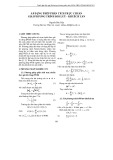
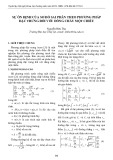
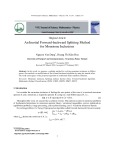
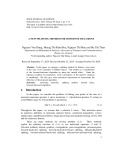
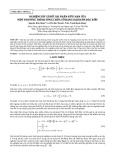
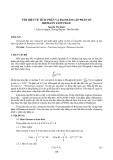
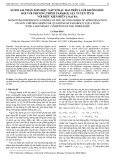

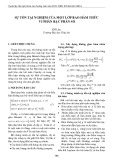















![Quyển ghi Xác suất và Thống kê [chuẩn nhất]](https://cdn.tailieu.vn/images/document/thumbnail/2025/20251030/anh26012006/135x160/68811762164229.jpg)
